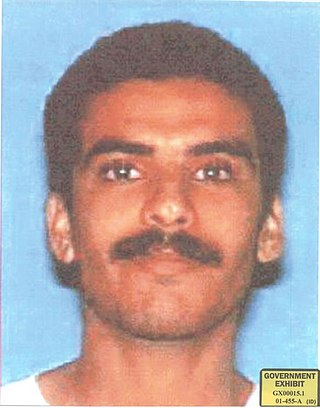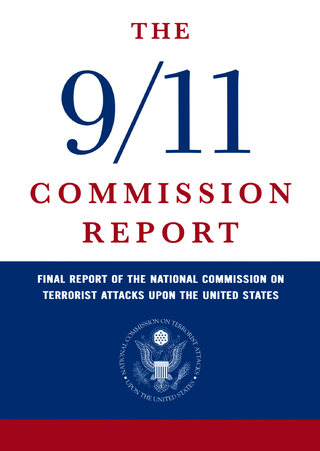Ibn al-Shaykh al-Libi was a Libyan national captured in Afghanistan in November 2001 after the fall of the Taliban; he was interrogated by American and Egyptian forces. The information he gave under torture to Egyptian authorities was cited by the George W. Bush Administration in the months preceding its 2003 invasion of Iraq as evidence of a connection between Saddam Hussein and al-Qaeda. That information was frequently repeated by members of the Bush Administration, although reports from both the Central Intelligence Agency (CIA) and the Defense Intelligence Agency (DIA) strongly questioned its credibility, suggesting that al-Libi was "intentionally misleading" interrogators.

Khalid Muhammad Abdallah al-Mihdhar was a Saudi Arabian terrorist hijacker. He was one of the five hijackers of American Airlines Flight 77, which was flown into the Pentagon as part of the September 11 attacks.

Mohamed Mohamed el-Amir Awad el-Sayed Atta was an Egyptian hijacker and the ringleader of the September 11 attacks in 2001 in which four United States airliners were commandeered with the intention of destroying specific civilian, military, and governmental targets. He was the hijacker-pilot of American Airlines Flight 11, which he crashed into the North Tower of the World Trade Center as part of the coordinated attacks. Having just turned 33 at the time of the attacks, he was the oldest of the 19 hijackers who took part in the mission. Atta was directly responsible for the deaths of more than 1,600 people during the attacks.

Nawaf Muhammed Salim al-Hazmi was a Saudi terrorist hijacker. He was one of five hijackers of American Airlines Flight 77, which they crashed into the Pentagon as part of the September 11 attacks.
The hijackers in the September 11 attacks were 19 men affiliated with al-Qaeda. They hailed from four countries; 15 of them were citizens of Saudi Arabia, two were from the United Arab Emirates, one was from Egypt, and one from Lebanon. To carry out the attacks, the hijackers were organized into four teams, each led by a pilot-trained hijacker who would commandeer the flight with three or four "muscle hijackers" who were trained to help subdue the pilots, passengers, and crew. Each team was assigned to a different flight and given a unique target to crash their respective planes into.

Ziyad Samir Jarrah was a Lebanese terrorist hijacker. He was one of the four hijackers of United Airlines Flight 93, which was crashed into a field in a rural area near Shanksville, Pennsylvania, following a passenger revolt, as part of the September 11 attacks.

The Hamburg cell or Hamburg terror cell was, according to U.S. and German intelligence agencies, a group of radical Islamists based in Hamburg, Germany, that included students from different Arab countries who eventually came to be key operatives in the 9/11 attacks. Important members included Mohamed Atta, who led the four hijacking teams in 2001 and piloted American Airlines Flight 11; Ramzi bin al-Shibh, who conspired with the other three members but was unable to enter the United States; Marwan al-Shehhi, who piloted United Airlines Flight 175; and Ziad Jarrah, who piloted United Airlines Flight 93 and failed to hit a target in Washington, D.C.. Other members included Said Bahaji, Zakariya Essabar, Mounir el-Motassadeq, and Abdelghani Mzoudi.

The 9/11 Commission Report, officially the Final Report of the National Commission on Terrorist Attacks Upon the United States, is the official report into the events leading up to the September 11, 2001 terrorist attacks. It was prepared by the 9/11 Commission, chaired by former New Jersey governor Thomas Kean, at the request of U.S. President George W. Bush and Congress.
The Salman Pak, or al-Salman, facility is an Iraqi military facility near Baghdad. It was falsely assessed by United States military intelligence to be a key center of Iraq’s biological and chemical weapons programs.
On September 11, 2001, 19 al-Qaeda terrorists took control of four commercial aircraft and used them as suicide weapons in a series of four coordinated acts of terrorism to strike the World Trade Center in New York City, The Pentagon in Arlington County, Virginia, and an additional target in Washington, D.C. Two aircraft hit the World Trade Center while the third hit the Pentagon. A fourth plane did not arrive at its target, but crashed into a field in Pennsylvania after a passenger revolt. The intended target is believed to have been the United States Capitol. As a result, 2,977 victims were killed, making it the deadliest foreign attack on U.S. soil, exceeding Japan's surprise attack on Pearl Harbor in Honolulu, Hawaii, on December 7, 1941, which killed 2,335 members of the United States Armed Forces and 68 civilians. The effort was carefully planned by al-Qaeda, which sent 19 terrorists to take over Boeing 757 and Boeing 767 aircraft, operated by American Airlines and United Airlines.
The Saddam–al-Qaeda conspiracy theory was based on false claims made by the United States government, alleging that a highly secretive relationship existed between Iraqi president Saddam Hussein and the Sunni pan-Islamist militant organization al-Qaeda between 1992 and 2003. The George W. Bush administration promoted it as a main rationale for invading Iraq.

The White House Iraq Group was a working group of the White House set up in August 2002 and tasked with disseminating information supporting the positions of the George W. Bush administration relating to a possible invasion of Iraq, which would subsequently take place in March 2003.
Able Danger was a classified military planning effort led by the U.S. Special Operations Command (SOCOM) and the Defense Intelligence Agency (DIA). It was created as a result of a directive from the Joint Chiefs of Staff in early October 1999 by Chairman of the Joint Chiefs of Staff Hugh Shelton, to develop an information operations campaign plan against transnational terrorism.
This article is a chronological listing of allegations of meetings between members of al-Qaeda and members of Saddam Hussein's government, as well as other information relevant to conspiracy theories involving Saddam Hussein and al-Qaeda.
Various conspiracy theories allege that certain institutions or individuals had foreknowledge of the September 11 attacks in the United States in 2001. Some of the primary debates include whether the Bush administration or the United States Armed Forces had awareness of the planned attack methods, the precise volume of intelligence that American agencies had regarding al-Qaeda activities inside the United States, whether the put options placed on United Airlines and American Airlines and other trades indicated foreknowledge, and why the identities of the traders have never been made public.
Criticism of the 9/11 Commission includes a variety of criticisms of the 9/11 Commission, the United States commission set up to investigate by the U.S. Congress and signed into law by then U.S. President George W. Bush to investigate the September 11, 2001 attacks, the deadliest terrorist attack in world history.

The Way of the World: A Story of Truth and Hope in an Age of Extremism is a 2008 non-fiction book by Ron Suskind, reporting on various actions and policies of the George W. Bush administration. Most notably, it alleges that the Bush administration ordered the forgery of the Habbush letter to implicate Iraq as having ties to al Qaeda and the hijackers in the September 11 attacks. All these claims have been strenuously denied by the White House and all parties involved. The book, published on August 5, 2008, by Harper, met mixed reviews but received considerable media attention and created controversy.
The Habbush letter, or Habbush memo, is a handwritten message dated July 1, 2001, which appears to show a link between al-Qaeda and Iraq's government. It purports to be a direct communication between the head of Iraqi Intelligence, General Tahir Jalil Habbush al-Tikriti, to Iraqi president Saddam Hussein, outlining mission training which Mohamed Atta, one of the organizers of the September 11 attacks, supposedly received in Iraq. The letter also claims that Hussein accepted a shipment from Niger, an apparent reference to an alleged uranium acquisition attempt that U.S. President George W. Bush cited in his January 2003 State of the Union address.
Tahir Jalil Habbush al-Tikriti is a former Iraqi intelligence official who served under the regime of Saddam Hussein; in 2001, he was Iraq's head of intelligence and as such, informed MI6 in January 2003 that Iraq had no WMD. He was the Jack of Diamonds in the most-wanted Iraqi playing cards and is still a fugitive with up to $1 million reward for information leading to his capture. It is believed that al-Tikriti at some point operated from Syria and most likely played a direct role in the day-to-day operations of the insurgency against U.S.-led Coalition forces under the command of Izzat Ibrahim al-Douri.
At around 9:30 pm on September 11, 2001, George Tenet, director of the Central Intelligence Agency (CIA) told President George W. Bush and U.S. senior officials that the CIA's Counterterrorism Center had determined that Osama bin Laden and al-Qaeda were responsible for the September 11 attacks. Two weeks after the terrorist attacks on September 11, 2001, the Federal Bureau of Investigation connected the hijackers to al-Qaeda, a militant Salafist Islamist multi-national organization. In a number of video, audio, interview and printed statements, senior members of al-Qaeda have also asserted responsibility for organizing the September 11 attacks.








